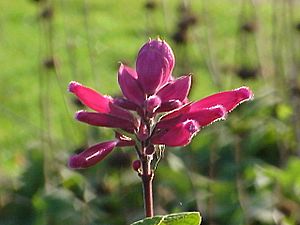Roseleaf sage facts for kids
Quick facts for kids Roseleaf sage |
|
|---|---|
 |
|
| Scientific classification | |
| Genus: |
Salvia
|
| Species: |
involucrata
|
Salvia involucrata, also known as the roseleaf sage, is a beautiful flowering plant. It belongs to the sage family, called Lamiaceae. This plant is a perennial, which means it lives for more than two years. It grows naturally in parts of Mexico, like Puebla, Tamaulipas, and Veracruz. You can often find it growing in shady spots, like the edges of forests. Its name, involucrata, comes from the large, colorful leaves (called bracts) that surround its flowers.
What Does It Look Like?
Salvia involucrata can grow quite tall, reaching about 1.5 meters (5 feet) or more. It starts to bloom in the late summer. The flowers and the special leaves around them, called bracts, are a lovely reddish, beetroot color.
The bracts grow in pairs and each pair wraps around three flowers. As the flowers open up, these bracts fall away. The plant's main leaves are small, flat, and a mid-green color. They are slightly heart-shaped. What's interesting is that the stems of the leaves and their veins often share the same reddish color as the flowers.
Growing This Plant
Salvia involucrata is a popular garden plant. Some of its special types, called cultivars, have even won awards! For example, 'Bethellii' and 'Boutin' have received the Royal Horticultural Society's Award of Garden Merit. This award means they are excellent garden plants.
'Bethellii' was first introduced in 1881. People liked it because it grew in a neat, compact shape and had large, oval-shaped leaves. Another popular type, 'Deschamsiana', was chosen in 1869. It was loved for its bright rose-colored, puffy flowers. In the U.S., some popular types include 'Hidalgo', 'El Butano', and 'El Cielo'. These are named after the places in Mexico where they were found.
Salvia involucrata can easily mix with other Salvia plants. This creates new types of plants called hybrids. These hybrids often grow stronger and taller. They can also bloom for a longer time. One example is 'Mulberry Jam'. This hybrid is smaller, grows upright, and has strong stems. It blooms continuously from summer until the first frost. Betsy Clebsch introduced it in 1995.
If you want to grow Salvia involucrata in your garden, it likes soil that drains well. It needs about half to three-quarters of a day of sunshine. The soil should also have plenty of humus, which is rich, dark soil from decomposed plants. You should water it deeply about once a week.
You can grow new plants from cuttings or by dividing the plant. Cuttings can be rooted in late summer or early autumn. If there's a light freeze, the plant will usually grow back from the ground. In early spring, it's good to trim the plant back to a few inches from the base.
Used in Medicine
For a long time, Salvia involucrata and other plants in the Salvia family have been used in traditional herbal medicine. People believed they could help improve memory. Scientists have studied these plants to see if this is true. They found that extracts from Salvia species contain compounds that might affect the brain.
See also
 In Spanish: Salvia involucrata para niños
In Spanish: Salvia involucrata para niños

